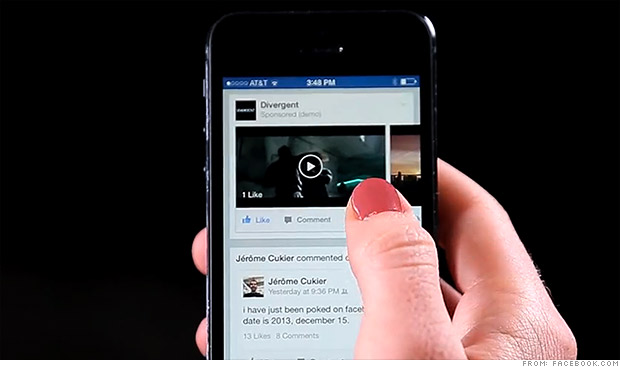Internet video ads are on the rise. They have been more influential than good old TV ads for quite some time now, having higher rates for message recall, brand recall, and ad likeability. We have been talking about that for quite some time here on the Shakr blog and we thought we should explain why Facebook’s video ads are so powerful right now, and something you as a marketer would be a fool to overlook. Traditionally, the leader of internet video ads has inherently been YouTube, who long have had a tight grip on the industry. With more than 1 billion users, billions of views generated each day, and an ad technology based on Google’s ever-so-successful advertising platform, Google’s wide range of efficient tools for marketers has been a big success and earned the Silicon Valley a lot of money. But now, there is a new industry leader in town. Facebook has been expanding its video ad capability, and the result is starting to show itself. According to a survey by Mixpo made early this year, whilst more advertisers ran ads YouTube than on Facebook, more advertisers answered that they plan to run an ad campaign on Facebook than on YouTube this year. This tells us that Facebook is taking over the mantle as the video ad industry leader. Therefore, we thought we’d give you a run down on the Facebook video ad strengths and do some comparisons with Youtube.

Facebook Video Ad Strengths
Its Algorithm
Facebook last year started to tweak its algorithm to promote video ads more effectively. In the second half of 2014, Facebook tweaked its News Feed algorithms so that videos most watched by people are likely to show up on others’ News Feeds, and it also purchased LiveRail last year to boost its ad targeting tech, something that they’re benefitting from now. Facebook know that its users are hungry for video content and that they don’t mind watching video ads. Facebook’s video ranking system now don’t only consider likes and shares, but takes into account whether people are actually watching each video — and for how long — before deciding who else will get the same video served as an ad. An enormously powerful change for marketers using the Facebook platform for their video ads.
Autoplay
Basically, the video ad plays automatically on the main Facebook timeline. Autoplay gives more chances of exposure to the viewers, because while on YouTube users actually have to watch a video to watch an ad, but with Facebook, scrolling through your timeline is enough to be exposed to an ad. Autoplay also solves Facebook’s longtime shortfall as an ad platform – mobile. While Facebook has gotten most of its user traffic from mobile for a while now, Facebook has not been a big name in the mobile ad space. With autoplay, Facebook can maximize ads’ exposure to its users.
Demographic data
Not only is Facebook’s user base bigger than YouTube, (1.44 billion vs 1 billion) it also has more demographic data on its users, which makes specifically targeting ads a lot easier. Targeting ad to the right audience is very important to marketers, as they all have fixed budget to spend, and having the right targeting capabilities can help them use their budget efficiently. You don’t want to show an ad targeted towards teenagers to a 50-year-old person. If you play around in the Facebook Power Editor you can find extremely powerful targeting settings, such as age, relationship status, job title, etc.
More social
Whilst YouTube is more of a video platform where people go to watch videos, Facebook is a social place. People aren’t afraid to share content they like, whether it is from a friend or in a sponsored brand post. If you create good content that your audience likes, chances are that they might help you spread the word about you. Don’t just expect any half assed video to get shared.

Facebook Caveats
While Facebook is rising quickly as the new contender in video ad wars (™), you should not ignore YouTube’s strengths. The data Google have on its users is really powerful as well, and might suit you better, depending on what kind of result you are looking for. Google knows very well what products its user are looking for, even if they didn’t specify it with a Facebook like. Also, you should not forget the long tail power of Google searches. According to a white paper done by Searchmetrics, 55% of search keywords in Google result in having at least one video in the results, and 82% of those results come from YouTube. This means when a user is searching for something specific, (especially a specific product) YouTube has a higher chance of being exposed. You may ask, “what about Facebook?” Well, Facebook is good for initial social reach and awareness, the fact is that it is quickly buried in the sea of other Facebook content and won’t easily turn up in search results in the long term. YouTube videos, on the other hand, can perform very well during a long time after the initial video is posted.
Conclusion
Facebook and YouTube has different approaches to video ads. While Facebook fares much better at targeting specific audience for the video ad, YouTube fares much better on exposures based on internet searches. You may ask which platform you should use, and the answer is “it depends, but probably both”. Experiment with both platforms and see what works best for you, as with most marketing activities there are no guarantees.



1 comments On Facebook Video Ad Strengths – Why Video Ads Are So Powerful On Facebook
Pingback: How To Set Up Facebook Video Ads - Shakr Blog ()
Comments are closed.